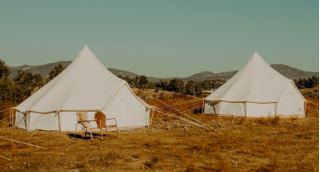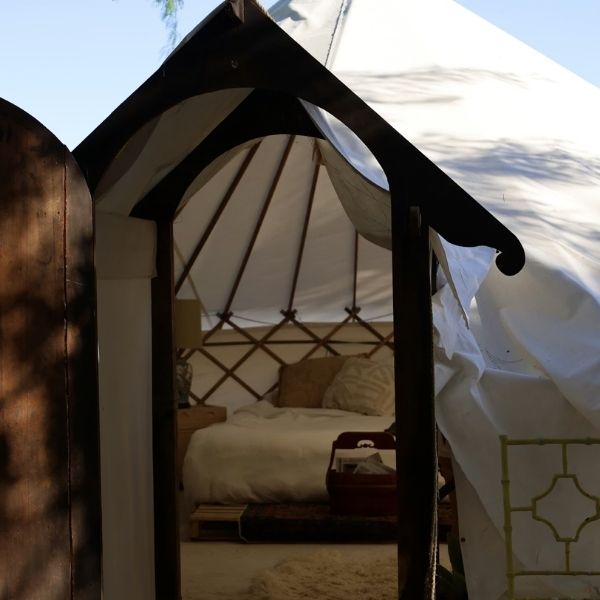Call Us: 1-971-220-8360
Free Shipping

Pay No Sales Tax
30-Month Warranty
Call Us: 1-971-220-8360
Tents
Shop


The LiT List
Glamping & Camping Ideas + Resources
Eco-Friendly Camping: How to Leave No Trace at the Campsite
4 min read
Whether you’re an avid thru-hiker or occasional car camper, any nature-lover or outdoorsy person like yourself should try their hardest to abide by the Leave No Trace principles. So, as you plan a camping trip and pack your camping tents, take time to consider how to minimize your impact on the environment. Here are some eco-friendly camping practices to remember so that you can Leave No Trace at the campsite and beyond.
How to Leave No Trace at Your Campsite
Let’s break down each of the 7 Leave No Trace principles and what it means in terms of camping.
Plan Ahead and Prepare
Before venturing out, familiarize yourself with the region and campground. Understanding your surroundings will help you better prepare and bring the right gear and equipment, making your camping experience far more enjoyable. It also helps to acknowledge your level of camping experience. First-time campers driving to a dedicated campground will need to plan and prepare much more differently than an overlander or backpacker.
Travel and Camp on Durable Surfaces

A campground will offer designated campsites, making it easy to follow Leave No Trace (LNT) principles. However, if you camp more off the beaten path, take care not to disrupt the area. Avoid creating unofficial “social trails” and new paths or campsites, which can damage vegetation and sensitive ground areas (muddy sites, fragile soil layers, etc.). Instead, stick to more durable surfaces like rock, sand, dry grass or solid dirt. Also, avoid camping near water sources (both to avoid any runoff and to respect wildlife’s access).
Dispose of Waste Properly
General waste, wastewater, and human waste should be disposed of properly. But how? Here are some basic tips on how to minimize each type of waste and dispose of it properly.
General Waste | Never bury, burn, or leave behind waste. Pack out any rubbish or drop off in a designated trash receptacle at the campground. Remember: Plan ahead, and you can limit single-use plastics and reduce camping waste as a whole.
Water Waste | Cleaning dishes, showering, bathing, and brushing teeth generate graywater, which should be disposed of properly. If possible, use the facilities provided, ensuring soapy water (think biodegradable soap!) goes down drains as intended. RV campers find this step easy (thanks to self-contained, built-in gray water tanks). However, car campers and backpackers will need to disperse and spread it out onto the ground at least 200 feet away from water sources, such as streams and lakes.
Human Waste | Use the campground facilities or hit up a pit stop whenever you head into town. Even if you don’t think you have to go – try! If these facilities are unavailable, you’ll need to carry it out (portable toilets come in handy!) or dig a cathole. Of course, no matter how biodegradable, pack out toilet paper and any other sanitary products.
Leave What You Find
This eco-friendly Leave No Trace guideline is straightforward. As the saying goes: "Take nothing but pictures. Leave nothing but footprints.” Just as you shouldn’t leave behind trash or create human impact, you shouldn’t take away parts of nature or the environment. In other words, never remove anything naturalfrom your campsite. You never know what non-native species you could transport or how desperately ecosystems and microorganisms might rely on it to survive.
So, no matter how beautiful that stone’s patterns look or how badly you want to propagate that plant, do not bring it home! Leave it in nature, where it belongs, exactly as you found it.
Minimize Campfire Impacts

The most obvious reason to minimize the use of campfires is to avoid causing accidental wildfires. Wildfires are not only dangerous and detrimental to the environment, but they also have far-reaching consequences. Campfire smoke alone also disturbs wildlife and harms surrounding vegetation. So what can you do?
Ensure campfires are permitted. Ask your camp host or local land management if there is a fire ban. Even if there’s no fire ban in effect, avoid building fires on hot or windy days – it’s not worth the risk.
Keep the fire manageable. Keep a small fire (in an existing fire pit, if possible) and designate someone to manage the fire, ensuring it doesn’t get out of hand. Under no circumstances should you leave a fire unattended or allow it to burn out overnight. And always extinguish any embers by pouring water over them. Or, if water is scarce, stir out the coals and cover them with dirt.
Use approved firewood. Check what type of firewood you’re permitted to bring. Many parks have restrictions on gathering wood on-site, as this harms the habitat of local wildlife. And never transport firewood long distances, as doing so can carry invasive species. Our suggestion? Even if fires and firewood are permitted, use an energy-efficient camp stove instead.
Respect Wildlife

Cute or dangerous, wildlife should be respected and given distance. Keeping wildlife wild is imperative, regardless of how friendly, cuddly, or hungry they may appear. So, never approach or follow an animal and never leave them nibbles or unsecured food scraps. This seemingly harmless act puts you, future campers, and even the animal itself at risk (by creating a food dependency). It doesn’t matter if it’s a bear or a chipmunk; give wildlife the space they deserve. Period.
The one exception might be if you stumble on an injured or abandoned animal. If this happens, take time to determine if it truly needs help. If so, alert an authority like the campground host and contact a wildlife rehabilitator who will know how to care for it.
Be Considerate of Others
Finally, just be polite and considerateto others. Whether you’re camping on a host’s land or visiting a National Park, treat fellow campers, locals, wildlife, and passersby with respect and courtesy. This means maintaining quiet noise levels (and allowing others to enjoy the sounds of nature) and abiding by any rules and restrictions.
Final Thoughts
This guide is by no means extensive. We encourage you to learn and understand how to follow Leave No Trace (LNT) guidelines, making adjustments to your personal camping style. By understanding the ethics and sustainable practices behind Leave No Trace, you may even discover and come up with better eco-friendly methods that work best for your family.
Related Resources

THE LIT LIST 4 min read
5 Reasons Yurt Tents Are the Ultimate Backyard Guest House
Hosting overnight guests? Consider a spacious backyard yurt tent as a spare guest room. Since many fHosting for the holidays or inviting overnight guests? Here are 5 reasons why yurt tents create the ultimate backyard guest room for your visiting family and friends. Affordable reason for selecting a yurt style tent for more permanent backyard glamping.

THE LIT LIST 2 min read
Black Friday Through Cyber Week Camping Tent Sales
Are you looking to save some money on purchasing a 2025 camping tent gift for that special someone? Popular Blogs
Camping Gift Ideas for People Who Have Everything
The Best Portable Tent Heaters - Ways To Heat A Canvas Tent
Glamping in Northern California: 8 Luxury Sites
Waterproofing A Canvas Tent - Retreating Canvas
33 Camping Quotes to Inspire Your Next Adventure
What Is Glamping? Origins, Definition, Destinations & More
10 Tips for Staying Warm While Winter Camping
How to Maintain and Clean a Bell Tent
Essential Family Camping Checklist: What to Pack [PRINTABLE]
Backyard Glamping Checklist for an Unforgettable DIY Glampsite
Popular Products
Subscribe
Sign up to get the latest on sales, new releases and tips
BECOME AN INSIDER
We’ll periodically share inspiration, bell tent releases, special offers, and event notifications with ya.



